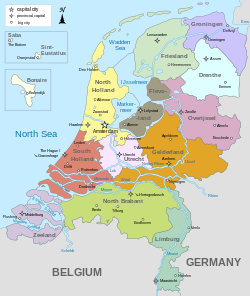Geology of the Netherlands
The geology of the Netherlands describes the
Fairly all of the west Netherlands is composed of the
In the east of the Netherlands, remains are found of the Saale glaciation, which ended approximately 130,000 years ago. As the continental ice sheet moved in from the north, it pushed moraine forward. The ice sheet halted as it covered the eastern half of the Netherlands. After the ice age ended, the moraine remained in the form a long hill-line. The cities of Arnhem and Nijmegen are built upon these hills.
Sedimentary succession

Paleozoic Era
The latest Permian deposits in the area of northwestern
Mesozoic Era
During Cretaceous times, most of the Netherlands was covered by a warm shallow (inland) sea in which thick successions of chalk were deposited. This is in places chert-bearing; chalk is mined near the southern city of Maastricht and the Maastrichtian stage was named after this locality. Here a number of mosasaur-fossils have been excavated as well. The Schoonebeek oil-bearing sandstones are Early Cretaceous in age and underlain by hydrocarbon-rich Lower Cretaceous lacustrine Coevorden Formation which forms the source rock for the east Netherlands oil.
Cenozoic Era
The Cenozoic is characterised by a further shallowing and erosion of earlier sediments. In places a reasonable thickness of Paleocene and Eocene sediments is reached, but most of the subsurface of the Netherlands lack deposits of this age.
The recent Netherlands is formed by
Tectonics and orogeny
Although the Netherlands seems to be a
See also
- Geology of southern North Sea
References
Wong, Th.E.; Batjes, D.A.J. & Jager, J. de; 2007: Geology of the Netherlands,
External links
- Geology of the Netherlands Archived 2016-06-06 at the Wayback Machine
- Geology map of Europe
